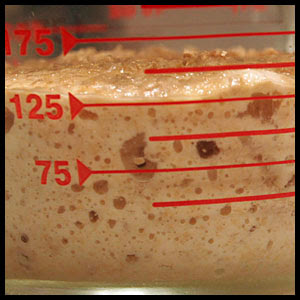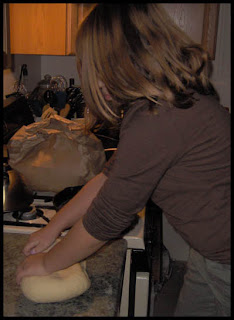 Mark Bittman's "No Knead Bread" is lighting a strange sort of fire under the buns of cooks the world over. It's kind of creepy, how this technique is spreading like a pandemic, but I understand why.
Mark Bittman's "No Knead Bread" is lighting a strange sort of fire under the buns of cooks the world over. It's kind of creepy, how this technique is spreading like a pandemic, but I understand why.
How long have we been subsisting on a diet of squishy, bland, overprocessed Wonder bread and its ilk? Pre-sliced, pre-packaged bread became the norm in the 20s and 30s thanks to Wonder Bread, and as supermarkets started to dot the country the average American grew lost to the art of breadmaking.
Bread as food is almost archetypal in the consciousness of humanity. We've been eating it for millenia. In fact, the cultivation of grain is widely considered to be the driving force behind homo sapiens' gradual transition from nomadic hunter-gatherers to settled colonists some 10,000 years ago. Bread is why we are who we are now.
In terms of breadmaking, the process itself hasn't changed too terribly much over the ages. Grains were ground fine, they were mixed with liquid and some sort of leavening, or rising, agent, and they were heated until cooked. These ancient peoples had to work a little harder for their leavening, though; the dough would be left to "rest" for several hours or more to allow wild yeast to take hold and raise the bread. Later, bakers discovered that the byproducts of beer- and winemaking produced an even lighter, fluffier loaf when used in their breads .
Today's breads are made with the same principles. True sourdoughs and other breads like Ethopia's flatbread Injera are allowed to ferment for several days in order to attract and cultivate the wild yeast that leavens the bread to varying degrees. Other breads are made with commercial packaged yeast - a different strain than the barm ancient bakers got from their brewer neighbors, but packaged and ready-to-go yeast nonetheless.
Sourdough bread. We think San Francisco when we think of sourdough bread today, but its history dates back to ancient Egypt. Bakers would reserve a piece of dough from the day's breadmaking to use in the next day's loaves. That piece of dough is essentially identical to today's sourdough starters - the carefully nurtured batter that gives sourdough its characteristic "tang" thanks to the inclusion of harmless, but tasty, bacteria that ride along with the yeast.
Making and maintaining a sourdough starter, much like breadmaking itself, is a labor of love. It's kind of like a pet that isn't fuzzy and doesn't cuddle up to you while you watch TV. It just sits there, smelling funny, waiting for you to feed and coddle it.
Sourdough Starter
1 cup flour
1 cup water
1 T sugar or honey
1 small piece of apple or 1 grape
note: Do
not use metal containers or utensils when working with your starter.
Place the above ingredients in a glass, ceramic, or plastic container. Mix well using a plastic or wooden spoon until it forms a thick batter.
Cover with a clean cotton towel and place in a warm spot, preferably on a windowsill with the window cracked open.
After 24 hours, remove 1 cup of the batter and add 1/2 cup flour and 1/2 cup water. Mix well. This is called "feeding" your starter.
Let it sit another 24 hours, and repeat the feeding process.
Continue feeding your starter every 24 hours until it has a nice, sticky, bubbly froth over top and bubbles throughout. It will also smell sorta soury-beery. It may take 3 days, it make take over a week. This depends on the yeast in your locale, the conditions in your windowsill (or wherever your starter lives), or perhaps the price of silver. A sourdough starter is a highly personalized thing and each one is different.
And if you're sitting there after 10 days with a stinky, non-bubbly mess...well, that's okay. The temperature may have been too cold, who knows. Occasionally it just doesn't work. Try again, and if it still doesn't work then the wild yeast in your locale might be a bit sluggish. Start the process again, but this time add a pinch of packaged yeast to the batter. That'll kickstart the process and give your wild yeast a nice happy home to move in to.
Caring for your starterOkay, this is the cool part. Once you've gone through all that to get a working starter, you really only have to worry about it about once a week afterwards! Switch that cotton towel out with a loose fitting lid and store your starter in the refrigerator. I like to use the plastic 2 quart drink pitchers with a pouring spout that you can get at any discount store; they're plastic, they're cheap, the lid is perfect, and it has a freakin' spout for pouring!
note: a pungent, straw- or brown-colored liquid will appear on top of your starter. That's supposed to happen. This is called hooch; just stir it back into your starter.
Once a week, remove 1 cup of starter and replace it with 1/2 cup of flour and 1/2 cup of water. Let it sit in a warm spot for 24 hours and return it to the fridge. That's all there is to it! You can make bread now.
Kept properly and fed regularly, a sourdough starter will literally last forever. Some bakeries use starters that were first created more than a hundred years ago!
Breadmaking is a very Zen experience. Many people today shy away from it because they think it's difficult, or because they think it just takes too darn long. I used to think that too, and resorted to paying $5 a loaf for "fancy" bread that tasted significantly better than Wonder Bread, but generally nowhere near as good as I now know the homemade stuff tastes.
Here's a secret: making bread is not difficult, and your actual interaction with the pre-baked product is maybe 20 minutes or so. When your bread is rising, you don't have to
do anything with it. Hell, you don't even have to be home. Mix everything up, and go take a bath or clean the house or get your nails done. It'll be just fine.
"But...but...I have to go to my kid's school play which will take two hours, and my dough is only supposed to rise 1 hour!"That's okay. Bread will work around your schedule. Here are the two big rules about bread:
1) Sweetening agents and/or heat will make the yeast work faster
2) Salt and/or cool temperatures will slow the yeast way down
The faster yeast work, the quicker your bread rises. The slower they work, the slower your bread rises. Mix and knead your dough and stick it in the fridge overnight to bake the next day. It's all good. Hold it in the fridge while you're at the school play and take it out when you get home. It'll be fine.
In fact, most breads, sourdough or not, have a better flavor if you let them rise in the refrigerator for a long period of time! The slow rise allows for some friendly bacteria to hang out with the yeast, and those bacteria taste good! You just let the bread do its thing, and it'll let you do your thing.
It's chill like that.
And no, it's not difficult to mix and knead bread. Modern conveniences like a stand mixer make the process a bit quicker, but you don't need one to turn out loaves that'll make the bakery at your local grocery weep jealously. All you really need is a sturdy wooden spoon and about 10 minutes worth of elbow grease.
I actually
like to get down and dirty with a blob of bread dough. It's vaguely meditative, actually. You don't need to think about what you're doing, you just let your hands work the dough while you ponder world peace, the meaning of life, or what the heck happened on the last episode of Heroes.
Push. Fold. Pull. Turn. Push. Fold. Pull. Turn.Ten minutes later, you have bread dough along with enlightenment.

No excuses allowed, unless you like don't have any hands or something. My six year old stepdaughter can knead a batch of dough that turns out two large loaves. She has to stand on a chair to reach it, too.
If a six year old can make bread and make it well, then you can too. You wouldn't want to be upstaged by a six year old, would you?
You'll notice that Munchkin is up high enough to exert a good amount of downward pressure on the dough. Let gravity do some of the work for you in the kneading process; get that dough on a slightly lower surface and your hands won't tire like they will if you knead on your normal work surface. You've got bodyweight on your side now.
Sourdough Bread1 cup starter
1 1/2 cups bread flour
1 1/2 cups warm water
1 T sugar or honey
Mix the above well in your mixing bowl. Let it sit, covered, at room temperature until the mixture bubbles and froths, or for up to 10 hours. This is called a sponge.
(you can do this before bed, then mix the dough before work, and have fresh bread for dinner that night!)
To your sponge, add:
1 stick (8 T) unsalted butter, melted
1 T salt
4 cups bread flour
Mix well with a spoon or with the dough hook attachment of your stand mixer. Watch the consistency of the dough; you want a soft, slightly sticky dough that easily comes together in a ball (and will cling to your dough hook if using a mixer). If the dough is too sticky, add more flour 1 T at a time. If it's too dry or stiff, add more water 1 T at a time. The dough is done when it's soft, springy, and a bit sticky.
Knead the dough by hand for 10 minutes, or by machine for 5 minutes. It will lose its stickiness and will become supple and smooth, almost like a baby's bottom.
Transfer the dough to a lightly greased bowl and cover with plastic wrap or a clean cotton towel. Let rise at room temperature for about 1 hour, or until doubled in bulk. You can also pop the covered bowl in your refrigerator and let it rise there for 8-10 hours.
Punch the dough down by gently smooshing your fists into it.
Divide in half and shape into two loaves - either into log shapes to fit bread pans or free-form oval loaves.
Cover and let rise about 45 minutes, or until doubled in bulk.
Preheat oven to 350*
When the loaves have risen, use a sharp knife or a razor blade to make 1/4" to 1/2" deep slashes across the tops. There are several "designs" you can use when slashing your bread, but with loaf shapes the most common is one long vertical slash, or 3 or 4 slightly diagonal ones. This gives the bread more room to expand in the oven, and it looks pretty cool too.
Brush with an egg wash or some melted butter. (for this recipe, I like to brush with melted butter and top with a sprinkle of kosher salt)
Bake for 25-30 minutes, or until the loaves sound hollow when tapped.
Cool on a wire rack and enjoy!
Don't forget to replace the part of your starter you used by adding 1/2 cup flour and 1/2 cup water. Let it sit out for 24 hours before returning it to your refrigerator.





















